Hall of fame
Last year, various winners of the Dau Barcelona Award for a life dedicated to games, including Dan Glimne, Tom Werneck and David Parlett, suggested that there should be a space dedicated to the posthumous recognition of the historical figures within cultural history that over the centuries have made significant contributions to disseminating and developing games and, specifically, board games. No sooner was the space suggested than it was created and presented at the Dau Barcelona 2019 awards ceremony gala by Dan Glimne, along with the first members of this unique hall of fame.
- Hall of Fame 2019 Introduction Speech, by Dan Glimne
- Alfons X. of Castile, called El Sabio, by Tom Werneck
- Lizzie Magie, by David Parlett
- Stewart Culin, by Oriol Comas i Coma
- Gerolamo Cardano, by Dan Glimne
- Johan Huizinga, by Tom Werneck
- Roger Caillois, by Tom Werneck
- Johann Christoph Friedrich GutsMuths
- Klaus Teuber
Hall of Fame 2019 Introduction Speech
Hall of Fame 2019 Introduction Speech, by Dan Glimne
Ladies and gentlemen.
We have witnessed awards being handed out this evening; awards for clever game designing, as well as for another professional life dedicated to the wonderful, vast, fascinating subject of games.
I like to think that we are actually – right now, historically speaking – experiencing a golden age of games: with boards and pieces, with cards and dice, with tiles and electronics and many other things. Never before has the intellectual variety been so great in games, and never before has their artwork, and their physical design, been so exquisite and appealing.
But this enjoyable state of things has of course not come about by itself. All of us here, award-winners and game designers and players alike, are standing on the shoulders of other men and women who went before us – and who once imagined and created new ideas and things in the world of games, some of which today even seem so self-evident to us that we often fail to think of them as inventions.
Somewhere on the African savannah, perhaps a hundred thousand years ago or so, an ancestor of ours threw a piece of bone or stone on the ground and considered it important which side would fall upward – and thus the concept of dice was born. About twelve-hundred years ago, some noble or lady-in-waiting at the Chinese court took a closer peek at paper money and was suddenly struck by the thought that it was possible to create a game using these notes in various denominations – and so the first playing-cards were born. And some nine-hundred years ago, most likely in Persia or India, a third person saw these early playing cards in action – and came up with the concept of trick-taking.
And this is just to pick three single moments in the long, winding, rich history of games. But who were the men and women behind these three particular momentous insights that I just mentioned? Unfortunately, their names have long been lost in the mists of history. That is truly regrettable.
But there have, over the centuries, been many other such insights, inventions, concepts and creative steps, one after the other – and by persons we DO know the name of, and whose work we who have come afterwards have drawn upon, expanded, improved further, and incorporated into our modern games. It is only right and fair that these historical persons deserve – belatedly – recognition for their intellectual creations and significant contributions to the ongoing, never-ending process of thinking up and enjoying better games.
And thus, for this purpose, we have instituted the DAU Barcelona Hall of Fame, which we inaugurate tonight. The purpose of this Hall of Fame is to honour those persons who in the history of humankind took important steps towards our enjoyment and understanding of what games are, how they function, why we play... and thus they have enriched the cultural heritage that is ours.
But there have, over the centuries, been many other such insights, inventions, concepts and creative steps, one after the other – and by persons we DO know the name of, and whose work we who have come afterwards have drawn upon, expanded, improved further, and incorporated into our modern games. It is only right and fair that these historical persons deserve – belatedly – recognition for their intellectual creations and significant contributions to the ongoing, never-ending process of thinking up and enjoying better games.
After many discussions among those of us who have previously been awarded the DAU Premi Especial trophy, for this inauguration we have eventually chosen four inductees into the DAU Barcelona Hall of Fame: four persons from different epochs and places in history, but all of whom ultimately shared a love of games, and whose contributions in many ways underlie the games that we play and enjoy today. Over the coming years, they shall be followed by others.
Alfons X. of Castile, called El Sabio
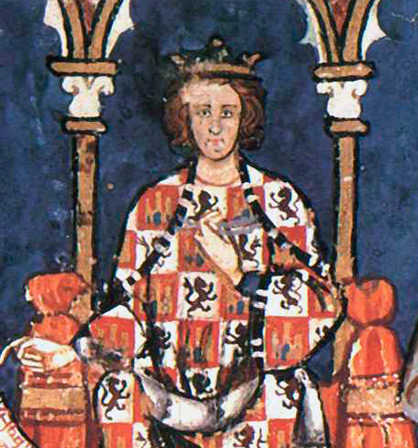
Alfons X. of Castile, called El Sabio, by Tom Werneck
Alfonso X, called El Sabio, was born on 23 November 1221 in Toledo. He earned his epithe ‘the wise’ not for his political skills but for his life’s achievements in the field of legislature, science and culture. Politically, however, he was as unsuccessful as he was ambitious.
In 1252, at the age of 31, Alfonso became king of Castile and León. First, he scored some minor successes when he was able to recapture main centers of Andalusia from the Moors. But he failed in his attempt to gain the Roman-German kingship for the prestigious imperial crown, although he was a grandson of the Staufer king Philip of Swabia.
An electoral stalemate led to an interregnum. In 1273, after the death of Richard, Earl of Cornwall, the electors chose Rudolf I of Habsburg as Roman-German king. Alfons' way of rigorously exploiting the economy, clumsy treatment of the nobility and, last but not least, even disputes over the throne meant that he was disempowered in 1282. Only his royal title was he allowed to keep. He died alone on April 4, 1284 in Seville.
The list of scientific and cultural institutions he had established is as long as the list of works he either wrote himself or commissioned. However, at the end of the list the Libro de los juegos: acedrez, dados e tablas is often paid little attention - if it is mentioned at all.
However, this wonderful book, an original of which is in the library of the monastic residence Real Sitio de San Lorenzo de El Escorial, documents the rules of many board games and is considered the first and most important collection of chess problems of the Middle Ages. At least, no other book is known that collected together the board and dice games popular at that time.
At first sight it seems to be an exercise book for chess, because it contains 103 chess problems. Almost all are Arabic mansubat, or endgame problems – the forerunners of checkmating and other study problems still common today.
To transfer precious Arabic and Jewish knowledge into Christian Europe, Alfons founded a translator school in Toledo and established Jewish, Muslim and Christian scholars. His admiration for Arabic precision of thought is shown by the extent to which he had concentrated on chess in the book of games.
Following the basic idea of thesis, antithesis, synthesis, Alfons divided games into three categories. For him the book of chess games represented the area of the mind. The book of dice games, on the other hand, related to chance. And last but not least, the book of Tricktrack games linked these two basic human orientations through the medium of reason.
Chess occupies the dominant part of this book of games with 64 in a total of 100 sheets. He dedicated seven pages to a dozen dice games and nine to 15 Tricktrack games. The remaining 20 pages, of which only 18 are still available, illustrate a rich and playful range, as they explain Great Chess, eight-sided dice, 8-man Tricktrack, 10x10 Chess (of these two games both pages are missing), 7-sided dice, 7-man Tricktrack, Four-season-Chess, "The World" Tricktrack, Alquerque and, last but not least, Sphere Chess and Planet Tricktrack.
An emperor who showed an open mind through his tolerance of other religions and cultures, who advanced legislation, the development of the national language and many different scientific developments, and who left us a comprehensive documentation of medieval culture, deserves a place in the Hall of Fame!
Lizzie Magie
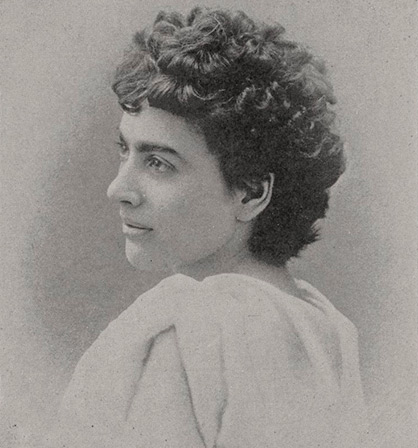
Lizzie Magie, by David Parlett
Elizabeth Magie Phillips, known better as Lizzie Magie, invented Monopoly – “the world’s most famous game”, as it is rightly called in Phil Orbanes’s book of that title. This fact alone gives her a rightful place in any game-players Hall of Fame.
Everybody knows Monopoly, but not everybody knows the story behind it or how old it really is. For many years its publishers, Parker Bros, claimed it was invented in 1933 by Charles Darrow, an out-of-work heating engineer. But it has recently become clear that Darrow’s game grew out of a game patented by Lizzie Magie in 1904 under the title The Landlords Game, or just Landlords.
Landlords was not designed as an amusing game for children. In fact it was a political game for adults, designed as propaganda for the single-tax theory of economist Henry George, who maintained that in a just society taxes were unnecessary and all Government revenue should come from rent. The land belongs to the people and the holders should pay for its use. Landlords was an anti-capitalist game, quite the reverse of what we now know as Monopoly.
But Lizzie was a clever and inventive woman who had already had one game published, and the essential playing elements of Landlords were entirely original. We can see that it is an advanced type of race game, of the same family as the traditional European game of Goose, but greatly altered. Instead of aiming to be the first to reach home, you keep racing round a continuous circuit until all but one player have exhausted their resources (money) and have to drop out. The one remaining is the winner. Until Lizzie’s day the only traditional games of recirculation were varieties of Mancala. But Mancala games are entirely abstract, whereas Landlords/Monopoly begins to approach the modern concept of role-playing in board games.
Her other innovation was that of purchasing individual spaces of the board, owning and developing properties on them, from which you could earn revenue to enable you to continue the race. I think no one had ever done before.
Lizzie invented and published several other games during her life, but spent most of her time developing and refining the one closest to her heart. Its basic mechanisms have been borrowed time and time again in board games published throughout the 20th century. Monopoly itself has developed into many other varieties around the world. Only recently I went to London’s Natural History Museum and there purchased a version of Monopoly based on unearthing, buying and selling fossils of dinosaurs!
Stewart Culin
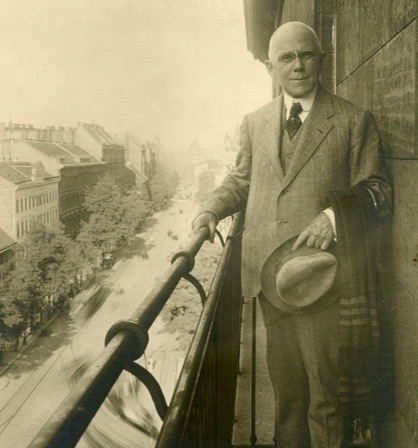
Stewart Culin, by Oriol Comas i Coma
Stewart Culin was born in Philadelphia in 1858. He was appointed director of the University of Pennsylvania’s Museum of Archaeology at the age of 34. Ten years later, he became Curator of Ethnology at the Brooklyn Institute of Arts and Sciences, a post he would remain in up to his death in April 1929.
Despite never having formally studied anthropology, he was always a remarkable scientist and had enormous expertise in this field. He was also interested, among other disciplines, in Chinese culture and in art and fashion. Notable aspects of his personality, according to the gaming historian Robert Charles Bell, were his frankness and unorthodox way of doing things and speaking. He wrote books on the medicine, religion, art, and popular culture of numerous countries, especially those in Asia, where he often travelled.
Above all, and hence his inclusion in the Dau Barcelona’s Hall of Fame, he conducted considerable research which led him to write about games.
His extensive bibliography features studies on the games of Korea, Japan, Syria, the Philippines, China, Hawaii, and India, and on mancala, chess, card games, and dominoes. His major work was the monumental Games of the North American Indians, published by the Smithsonian Institution in 1907. In fact, this book was part of the Bureau of American Ethnology's annual report of activities, in other words, it was an administrative document. Well, it would have been an administrative document had it not been accompanied by an “extended memoir”, namely, Stewart Culin's study.
Now, we were saying that this work was “monumental”. The volume consists of a 30-page report and a 846-page study on the games of the native North Americans. Eight hundred and forty-six 20x29 cm pages, with 1,112 illustrations by the author himself and 22 photographs and unpaginated engravings, one of which is a coloured frontispiece. The book was the result of a systematic collection of documents of every piece and item relating to the games of native North Americans found in museums in the United States and in private collections, and from the numerous expeditions he had made to Native American reserves, through which he built his own (enormous) collection.
The book on the games of native North Americans remains a reference work for researchers. To put it in the words of the head of the Bureau of American Ethnology, Stewart Culin's book “not only affords an understanding of the technology of the games and of their distribution, not only contributes in a remarkable manner to an appreciation of native modes of thought, but this paper practically creates the science of games and for the first time gives this branch its proper place in the science of man”.
Gerolamo Cardano
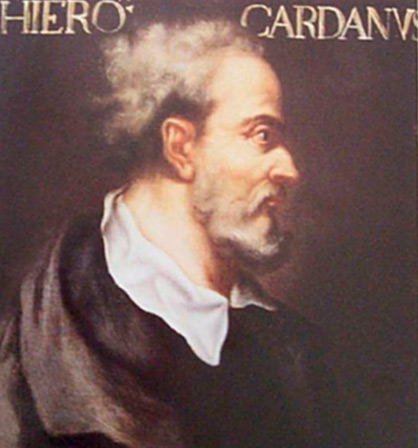
Gerolamo Cardano, by Dan Glimne
Of Gerolamo Cardano, it may be said that he was the first-ever gambler in history who knew what he was doing, and why.
Cardano was born in 1501 in Pavia, near Milano in present-day Italy, and went on to become a physicist, inventor, astronomer and mathematician. Among the things he invented are the Cardan shaft, still used in the drive train of many automobiles, and the combination lock. But it is in his works in the field of mathematics that we find the chief reason for Cardano’s induction into the Dau Barcelona Hall of Fame.
Gerolamo Cardano, for all his brilliance, had a few disputable character traits; and one of them was gambling. In fact, from about the age of 25 he had an irregular side income from chess, cards and dice. But unlike just about any other gambler of his day, he at the same time systematically collected facts about the games, and started to work out the mathematics inherent in a variety of situations occurring in them. And, he considered the role of luck and randomness in gambling.
The concept of randomness was at the time, in the mid-1500’s, a revolutionary concept. If you had asked the average person then about why the dice and the cards fell the way they did at the tables, the answer would have been that God had a hand in it, or perhaps some other powers that be. To even think that something could occur by chance, without any interaction initiated by gods, demons or magic, was at that time almost unheard of. But Gerolamo Cardano not only dared think that very thought, but also to put it in writing and analyze its ramifications, in his book Liber de Ludo Aleae which was finished around the year 1564 – the title being in Latin and meaning “the book on games of chance”. For reasons which are unclear to us, that book did however not appear in print until 1663, long after Cardano’s death in 1576.
And thus we have what can be said to be the very first analytical book on games in the Western world, describing them in terms of consistent rules, and discussing how games work from a mathematical standpoint. In fact, one particular thing Cardano did in that book was to come up with the novel concepts of odds and probability, defined as the proportions between good and bad and total possible outcomes in a situation. To be fair, Cardano did not get every fact right – but he may be forgiven for that, as he was a pioneer. And in the process, Cardano in his book also addressed the concept of justice and fairness in gambling, even from philosophical, legal and religious viewpoints; and warned against cheating, describing a variety of methods used in his day.
Since then, tens of thousands of books on gambling and other games have seen the light of day – but Cardano’s Liber de Ludo Aleae was the very first scientific one, daring to venture into the unexplored realms of randomness, and providing a cornerstone for modern probability theory. For this, Gerolamo Cardano earns the distinction of having a place in the Dau Barcelona Hall of Fame.
Johan Huizinga

Johan Huizinga, by Tom Werneck
Johan Huizinga (1872-1945): ‘Homo ludens’
"Play is a voluntary action or activity which is carried out within certain defined limits of time and space according to voluntarily accepted but absolutely binding rules, has its goal in itself and is accompanied by a feeling of tension and joy and an awareness of 'being different' from 'ordinary life'.” This is probably the most common and catchy definition of the game. It was developed by the Dutch cultural historian Johan Huizinga, who published it in 1938 in his book "Homo Ludens: Vom Ursprung der Kultur im Spiel".
Huizinga made two bold leaps of thought. One was to expand the common classification of 'homo sapiens' as a thinking and 'homo faber' as a making person to include the 'homo ludens', the playing person. From this he then derived the logical conclusion that the game must be more than that which spirit, reason or activity bring about. The first sentence in his book begins: "Play is older than culture". However, play in its most diverse manifestations does not precede culture, but is the connecting link through which culture is created in the first place.
According to Huizinga, the game has no immediate practical purpose as a mental or physical activity and is only played out of pure pleasure in itself. Play is also always voluntary action. As soon as an activity is compulsory, it is no longer a game.
Play separates itself from the everyday. In contrast to the necessarily purpose-bound everyday actions, play is purposeless. Huizinga even goes so far as to describe the game as superfluous because it can be interrupted or postponed at any time.
Moreover, game is always positioned within a temporally and spatially delimited framework. It has a beginning and an end and takes place in a delimited area or space. This can be a sacred space, an arena or even a battlefield as well as a game table or a theater stage. There are always rules or laws that all participants accept. Game is interaction between person and person. The players take on a role; they act "as if" and know this when they are representing or reproducing something. And finally, play is conflict. It is a competition, measuring oneself, showing off. It also contains chance and stake, which makes both outcomes possible: win and loss.
With these characteristics, Huizinga has set out the terrain which he fills with his theory of the game. He starts out from the realm of the religious, because the sacred also creates a space that is detached from everyday life with its own self-contained reality. Huizinga knowledgeably substantiates this thesis by referring to the religious character of the Pythian, Isthmic and Olympic Games in pre-Christian times, as well as that of processions and sacrifices in Rome. With systematic meticulousness, he examined other areas of life and placed them within his frame of reference.
The work 'Homo Ludens' was published shortly before the outbreak of the Second World War. Even at that time, Huizinga observed with disillusionment the descent of light-hearted playfulness into often organized seriousness in sports, board and card games, as well as in business, science, modern art, and last but not least in politics. Huizinga died in 1945, and he had witnessed the gradual disintegration not only of ancient warfare as competition but also of the later forms of rule-governed chivalric battle, upholding a polite and respectful treatment of one’s opponent.
Huizinga is one of the most important cultural historians of the 20th century. It is to his credit that he reoriented our view of the game. He was not interested in the game within culture, but in culture as itself a game, and so he regarded the game not as one cultural phenomenon among many others, but as a branch of philosophical anthropology. He has earned his place in the Hall of Fame!
Roger Caillois

Photo courtesy of the Institute of Ludology, Berlin
Roger Caillois, by Tom Werneck
Johan Huizinga (1872-1945): ‘Homo ludens’
3 March 1913 – 21 December 1978
Man, Play and Games. Mimicry and thrills.
(Les jeux et les hommes. Le masque et le vertige)
Caillois’ remarkable and ground-breaking study of play was published in 1961. Although he repeatedly emphasised the fundamental definition by the Dutch historian, Johan Huizinga, his foreword began with a critique of the latter's book, ‘Homo Ludens’, which was published in 1938. According to Caillois, Huizinga primarily examined the external structures of play, thereby ignoring the internal motivations that give every behaviour its real meaning. And he believed that Huizinga’s theory that play is a necessary - albeit sometimes insufficient - condition for the development of any culture was too narrow and the emphasis on playful competition too one-sided. Therefore, Caillois applied intellectual rigour to set about re-arranging the elements of play and defined four categories for these, distinguishing between the secular and the sacred.
Agon: in playful competition, players put their specific skills to the test, such as their strength, intelligence or memory. Example: chess.
Alea: when gambling, however, players are at the mercy of external forces, such as fate or chance. Example: roulette.
Mimicry o màscara: players assume the role of fictional characters and behave accordingly. Example: role play.
Ilinx: thrill-seeking through heightened perception. The stronger the emotions are, such as panic, fear or ecstasy, the greater the pleasure. Example: roller coaster.
However, Caillois didn’t consider these four categories in isolation, but usually as combinations thereof. He regarded poker, for example, as a combination of Agon, Alea and Mimicry, because it includes a mixture of the cards played or held in people's hands, the random distribution of the cards and bluffing.
He placed these four basic elements within a clever framework using the polarity of Paidia and Ludus. He described Paidia as uncontrolled fantasy and spontaneous improvisation, as experienced at festivals or concerts. On the contrary, Ludus restricts play: clear rules determined at the start of the game require thought, patience and a clever strategy, as with Go or Shogi.
All play can be classified within this framework, provided that six other basic principles are observed: 1. it is voluntary, 2. it is detached from everyday life, occupying its own time and space, 3. the result cannot be determined in advance, but is influenced by the players, 4. it is unproductive and creates no additional economic value, 5. players observe rules that deviate from those of everyday life, as well as from routine behaviours, 6. it involves unrealistic, imaginary worlds.
Although Caillois repeatedly emphasised Huizinga’s brilliance and depth of thought, he was also critical. So his remarkable ideas and definitions did not go unchallenged, but this does not diminish their importance. Individual areas of game research are now so highly developed that they form the basis of far-reaching decisions in many scientific disciplines. Social, economic, medical, meteorological, climate research and political decisions – to name just a few examples – are no longer conceivable without the mathematical principles of game theory. Nevertheless, there are still wider gaps in our knowledge of play than in almost any other scientific field. Any new research strategy must be based on solid foundations. Roger Caillois’s cultural and philosophical approach created an essential cornerstone for these foundations.
Johann Christoph Friedrich GutsMuths
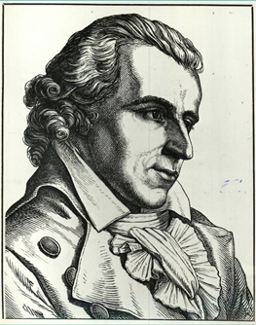
Klaus Teuber

Games by Klaus Teuber have been voted Spiel des Jahres (Game of the Year) four times. One, The Settlers of Catan, became a global success.
It is a fundamental characteristic of many complex analog games that they can be played effortlessly once the rules are understood, but only then. However, reading complicated rules and internalizing them in such a way that the game can be played without errors usually requires time-consuming work and learning process. This would also have been true for Catan, had author Klaus Teuber and editor Reiner Müller not invented and implemented a fundamentally new form of rule development. Instead of proceeding in the conventional way step by step via the description of the game goal and the material to the preparation and the structure, in order to then explain the individual process steps, moves, restrictions and possible special rules, the players found a sheet with an easily comprehensible model structure in the box. Eight speech bubbles, each with a short sentence, served as explanations. Reading the eight sentences took barely a minute. The first game could already begin.
This way of familiarizing users with a complex process in the shortest possible time and with little effort was groundbreaking. It was not only an essential component of the worldwide success of this game, but also a template for a fundamentally new understanding of rule design.
This made it possible to noticeably lower the entry hurdle of many complex games. Easier access made it possible for authors to incorporate intricate sequences into games, which increased the level of challenge and the quality of the content. Thus, many multi-layered games were brought out of their niche existence as specialist games and made accessible to a broader gaming public.
That alone would have been enough to secure Klaus Teuber a place in the Hall of Fame. But the impact of his game "The Settlers of Catan" is even more profound.
Art and culture often anticipate or depict long-term and fundamental social developments. If we compare Monopoly and The Settlers of Catan, these two games reflect in an almost visionary way the different basic attitudes that manifest themselves in the ideological, above all political conflicts of our societies. At the same time, these two titles are both vivid and representative representatives of two fundamentally different game cultures.
Monopoly is a perfect zero-sum game. Every win is at the expense of a fellow player. And it achieves this with simple means. The only decisions a player can make is whether to buy land or invest in buildings. Beyond that, he can only wait until a fellow player lands on one of his properties and has to pay, or until he himself lands so often on other people's properties that the rent payments lead to his bankruptcy. These are processes that largely elude the player's own decision-making and are subject to an uncontrollable automatism. The main goal is to drive the other players into bankruptcy.
Europe sees itself as having a different orientation than the USA. Even if it proves time and again to be a laborious and tough undertaking in practice, Europeans are persistently trying to dismantle barriers, open borders and draw connections and networks throughout Europe. Trade is not a greed-driven one-way street, but a free and voluntary give-and-take in the mutual interest of the partners. European policy manifests the idea of including as many people as possible and avoiding leaving behind isolated groups. For this reason, efforts are always made to include minorities and outsiders, even political troublemakers, as far as possible, even if this is time-consuming and sometimes grueling. It is fine for everyone to pursue their own strategies and goals in this process, as long as the overall balance is right. The basic assumption is the shared experience that growth brings prosperity. Not with a watering can for everyone equally, but a little more for some, and a little less for others who are less fortunate or not quite as skilled. But overall, the goal is steady improvement for all.
In the game The Settlers of Catan, all of these elements can be found again: creating far-reaching traffic routes, building settlements, and negotiating in order to reach a successful conclusion that is satisfactory for all involved. The fact that the Catan idea works so well is due to the clever basic structure with honeycomb-shaped tiles, which can be laid out to form ever new starting positions. On this variable basis, the action takes place with trading and negotiating, the balanced interplay between one's own planning and the randomness generated by the dice. The demand for flexibility, which a constantly reconfigured starting position requires as a fundamental characteristic of European politics, is also evident in the game. "Instead of direct conflict, German-style games tend to let players win without having to undercut or destroy their friends," said Andrew Curry in his paper "Monopoly Killer: Perfect German Board Game Redefines Genre. "Quantity limits on the hand or conversion actions that can be used to procure missing resources keep the market in a dynamic equilibrium, but where coveted resources fetch a higher price, for example, in exchange. Access to resources cannot be monopolized in this game.
A robber figure, which is used in the basic version and some other editions, only forms an annoying blockade for a while, but it can be removed and used elsewhere. A robber figure that does not destroy and does not rob the players of resources can serve as a brake for the one who has gained a greater advantage if the weaker players join forces and use the robber in concert. This element is also a reflection of a European idea aimed at balance. The rule of unanimity in important decisions of the European Union slows down the strong powers and gives the smaller, weaker countries the opportunity to catch up or negotiate a balance. The Settlers of Catan is a good example of the peaceful character of European thinking.
The term German or German-style games, now widespread in many countries, aligns other features of analog games in this category in parallel with basic political attitudes. Its characteristic is to keep the players involved right to the end, to seek a balance of interests based on negotiation rather than violent conflict resolution, and to value the pleasure of the shared game experience more highly than to achieve monopolizing dominance. In many American games, it is a basic pattern that one player after the other is eliminated and can no longer participate in the further course of the game. In the German Games, the opposite is true: everyone should remain involved in the action until the end, if possible.
Settlers who discover the unknown island of Catan and make it habitable for themselves are motivated by the hope of a peaceful, secure life. People who must leave their homeland strive for a peaceful, secure life in prosperity and without aggressive conflicts. Catan was the pioneering forerunner for a large number of games with a similar concept. They symbolically manifest the economic and cultural interplay of peaceful societies and are thus social games in the true meaning of the word.
The fact that Klaus Teuber has succeeded in transferring this fundamental concept to a game secures his place in the Hall of Fame.

